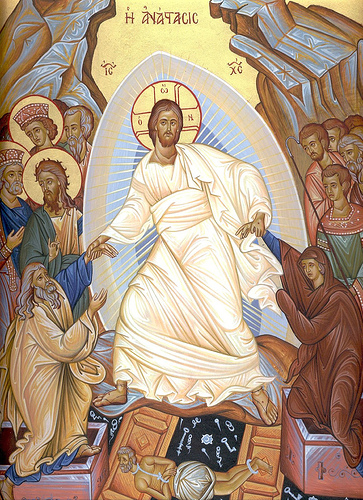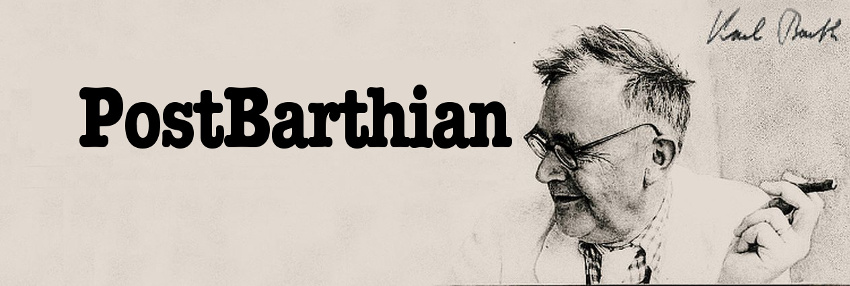
Eastern Orthodox Icon, Resurrection: Harrowing of Hell (source: wikipedia)
The Johannine Prologue (John 1:1-18) is a purple passage of the bible, and "In the beginning was the Word (λόγος), and the Word (λόγος) was with God, and the Word (λόγος) was God." (John 1:1 RSV) is among the most famous verses in the entire bible. The original Greek of John uses the ancient Stoic term λόγος (logos), which is translated as 'Word' in most all modern English translations, and occasionally as 'Speech' in some older translations. A myriad of books have been written on John's use of this Neo-Platonic and Stoic term.
John's employment of λόγος (logos) in John 1:14 is especially signification for the Christian formation of the doctrines of the Trinity and Incarnation. "And the Word (λόγος) became flesh and dwelt among us, full of grace and truth; we have beheld his glory, glory as of the only Son from the Father." (John 1:14 RSV). A surface reading may suggest that the second person of the Trinity (i.e. the λόγος) existed in a pre-incarnate and eternal form, and then at some point in history the second person assumed a human nature at the Incarnation.
The older orthodox Reformed Theologians saw a two phase life of the Second Person of the Trinity, first existing as the eternal λόγος and then a temporal appearance of the incarnate word. In a famous commentary on the Johannine Prologue in Karl Barth's Church Dogmatics Vol IV/2, Barth shows that there is no such thing as a λόγος ἄσαρκος (unincarnate Word). There is no such thing as a pre-incarnate or un-incarnate Word, and the most we may speak of an unfleshed Word is a logos incarnandus, which means 'a Word that will be incarnated'.
Karl Barth's brilliant exegesis has demonstrated that there is no "God behind God" that is unknown to us in the logos asarkos myth. The image of the invisible God, as Paul spoke, has always been the Crucified and Resurrected Jesus Christ, and if we imagine any logos asarkos, we must quickly speaks of it only as a logos incarnandus. Barth's following quotation has the great benefit, in that it does not fall into Lessing's Great Ugly Ditch, like the older Reformed explanation. Barth places the incarnation before all history, rather than being merely a contingent historical datum.
He "is the image of the invisible God, the firstborn of every creature: For by him were all things created, that are in heaven, and that are in earth, visible and invisible ... all things were created by him and for him: And he is before all things, and by him all things consist" (Col 1:15f.). It is to be noted that the One of whom all this is said is called "the head of the body, the church" and " the first-born from the dead" in Col 1:18, and that according to Col 1:20 it can be said of Him, this autos, that it pleased the Father in Him to reconcile all things to himself, "having made peace through the blood of his cross." But there could obviously be no sense in talking of the blood of the eternal Son of God as such, or of this Son as the firstborn from the dead. The declarations of predestination from Col 1:15 onwards cannot, therefore, relate only to the Son of God, to a logos asarkos.
But, again, the statement in John 1:2: "The same (autos en) was in the beginning with God," would be a meaningless repetition of the second statement in John 1:1 if it were not an anticipation of the incarnate Logos attested and declared by John the Baptist in the words: "This was he (outs en) who coming after me is preferred before me, for he was before me" (protos mou en). The result is that we cannot possibly refer abstractly to the eternal Logos either John 1:3: "All things were made by him; and without him (chorus auto) was not anything made that was made," or John 1:10 : "The world was made by him." The event attested in John 1:14 is one to which the whole Prologue looks back. So, then, the whole Prologue (with the possible exception of the first phrase of John 1:1) -- although it certainly speaks of the eternal Logos -- speaks also of the man Jesus. The saying in John 8:58, which reaches back to the Prologue: "Before Abraham was, I am," must be understood in the same way. And nothing could be more explicit than the way in which, in John 6:51, "the living bread which came down from heaven" is equated with" my flesh, which I will give for the life of the world."
But the same is true of Heb 1:2f., where it is said of the Son that by Him God made the aeons (the worlds), that He is "the brightness of his glory, and the express image of his person," and that He upholds "all things by the word of his power." For immediately after we are told that "when he had by himself purged our sins, he sat down on the right hand of the majesty in high," and (in Heb 1:4) is "made so much better than the angels, as he hath by inheritance obtained a more excellent name than they." This and the many statements which follow concerning his superiority to the angels would be quite inexplicable if the reference were only abstractly to the eternal Son of God, and He were supposed to stand in need of this exaltation and the inheritance of this more excellent name. Indeed, how could the eternal Son as such be put (in Heb 1:1) in the same series with the fathers by whom God spoke at sundry times and in divers manners? How could it be said of Him as such that God "hath in these last days spoken unto us" by Him? This is only explicable if, as is expressly emphasised in Heb 1:6, the reference is to the One who is brought into the world of men, the oikoumena, and therefore to the One who is both Son of God and Son of Man He as such is the One by whom God made the aeons, and who upholds all things by the Word of His power.
And so the One who (in 1 Pet 1:29) "verily was foreordained before the foundation of the world, but was manifest in these last times," is obviously the One of whom it is said to the readers in 1 Peter 1:18-19 that they are redeemed with His blood "as of a lamb without blemish and without spot." Again, the One of whom it is said in Eph 1:4 that God "hath chosen us in him before the foundation of the world, that we should be holy and without blame before him" is the One of whom it is said again in Eph 1:7 that we have redemption through His blood. Again, in Rev 13:8, the book of life written before the foundation of the world (which does not contain the names of those who worship the beast) is called the book of the Lamb slain. In all these predestinarian passages the emphasising of the blood, of the putting to death, of Jesus Christ is obviously inexplicable if they are referred to a logos asarkos, and not to the eternal Son of God and therefore also to the Son of Man existing in time.
Barth, Karl. Church Dogmatics IV/2 Study Edition 24. London: T & T Clark, 2010. 33-34. Print.



August 26th, 2014 - 07:54
Thank you for posting this; it’s been on the front burner of my studies as of late. I’m sympathetic to most of what I’m learning from Barth (and I’m still working through CD), but this is one area where I just don’t find the argument persuasive yet. Most of his points above could as easily be applied or explicated in terms of wisdom Christology, connecting Gen 1 & Prov 8 (and of course a bit of Wis 7). The “slain before the foundation of the world” language certainly seems to go beyond this, but I don’t see how that provides a full bridge to denying pre-incarnation, as opposed to simply seeing the cross as a fait accompli in the mind of God–which seems to me to be a restatement of the infra/supra-lapsarianism debate. Lastly, the argumentation here seems to gloss over the old/new creation distinction. I’m likely missing something and would appreciate your clarification.
August 26th, 2014 - 12:54
Ragan,
The infra/supralapsarian debate is in purview, as you noticed. In Barth’s Doctrine of Election in CD II/2, he demonstrates that the infralapsarian has no object of election, because the object of election has not yet been created, so supralapsarian has the advantage that it has an existing object of election, but Barth specifies that it is specifically Jesus Christ whom is this object of Election (Eph 1:4), and not as only a pre-incarnate logos, but the fully man and fully god Jesus Christ who is crucified and resurrected — this person, Jesus Christ, is the image of the invisible God, not a preincarnate logos. Separating the Divinity of Jesus from his Humanity, is nestorian and also brings about the critique that the true God is unknownable to us. The Ontological Trinity (the trinity in itself) is not truly revealed to us, and is a hidden God behind God of the Economical Trinity. Barth’s critique of the logos asarkos does not deny the incarnation, but guarentees that the logos of the trinity, is the very person of Jesus Christ who is revealed to us, such that there is no god behind god, but the Ontological Trinity is revealed to us in the Economic Trinity, and more specifically in the lamb that was slain before the foundation of the world. We know Jesus in time at calvary, but that is because the eternal logos incarnandus has eternal existed as Jesus Christ the crucified God. Otherwise, we fall into lessing ditch, where the humanity of God is an appendage to god, and really among the realm of creation, and we do not know the true god in Jesus, and all those problems that Friedrich Schleiermacher tried to work through in his God defined by “a feeling of absolute dependence”.
September 3rd, 2014 - 17:29
Hi Wyatt,
Great post! What do you say to those who claim Barth did not entirely deny the Logos asarkos, but only qualified it? I’ve been told Darren Sumner makes this argument in an article I’ve received but haven’t read yet.
September 1st, 2019 - 21:23
Hey, somehow I missed this comment. As you may guess, I’ll defer to Sumner’s opinion. He knows better. I like barth’s argument but there’s some counterpoints that need more addressing.
June 25th, 2021 - 06:16
Wyatt….your post was exceedingly helpful to me in disentangling the debates over the Logos Asarkos. Katherine Sonderegger has written on this in Vol II of her Systematic Theology (Doctrine of the Holy Trinity, p. 300): “It seems that Barth was not ready to fully abandon the Logos Asarkos, but he could be very bold on this matter.” She asserts that at times Barth’s “expansive claim dares to scale even the high wall between God’s Eternity and the creature’s historical time.” Most importantly, she asserts that “we must say that the very character of the Incarnate Servant should warn us off from an earthly Christ who tells all and everything about the Eternal Word.”